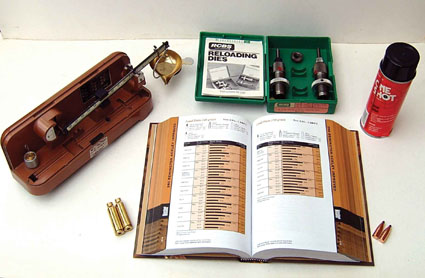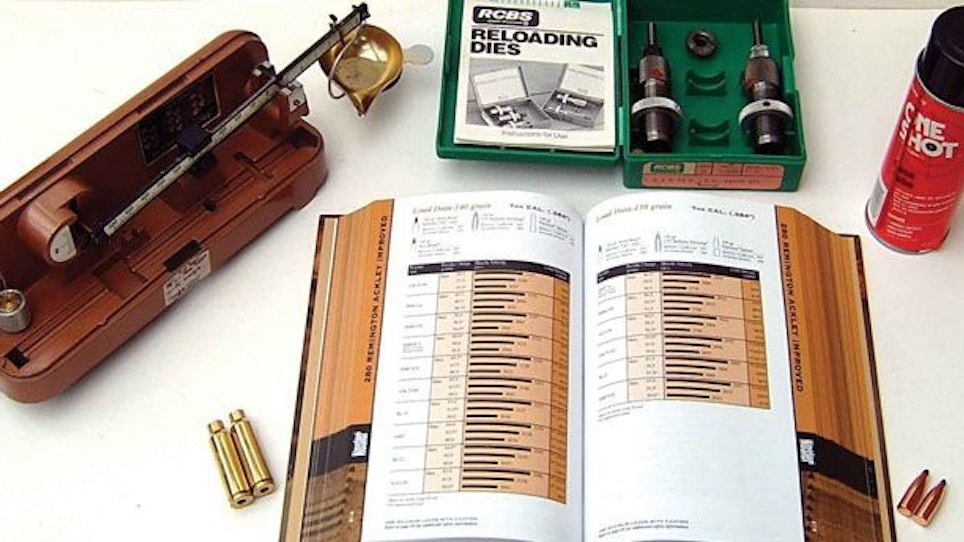 All the basic tools – except the press – needed to begin reloading. The two .325 WSM cases on left cost about $10.00 per box of 20, while a box of factory ammunition can be as much as $60.00. The former can be used many times by a reloader, but the latter only once by a non-reloader. |
Old reloading fogies like me have a tendency to forget that not all readers are reloaders. We also forget how much confusion and trepidation existed when we started. For would-be reloaders, I’ll try to make sense out of what many non-reloaders view as a black art.
Why reload? Economy, better ammo, and more practice are the most common answers.
Economy (although once a moot point) is again becoming paramount. The price of components, brass, lead, powder and primers, has skyrocketed in the last few years, causing the price of factory ammunition to go up even higher. Some ammunition now retails for over $100 a box and even the “economical” stuff is $20. Today, more than ever, it pays to reload.
While on the subject, “bargain basement” ammunition (not the “white box” stuff put out by the major ammunition companies, but foreign military surplus and non-reloadable junk) is bad stuff to be avoided. A lot of it is unsuitable for target practice or hunting.
The argument that a handload can be superior to factory ammunition is not as valid as it used to be. “Premium” factory ammunition is as accurate as most handloads, and the bullets used in premium ammunition are often the best that can be bought anywhere. Still, for those who want to hunt predators with a .32 Winchester Special and don’t want to ruin the hide, handloading is the way to go. Or, if you want a full-metal-jacket load for Pap’s .218 Bee, a varmint load for a .270 Winchester, or a wildcat-chambered rifle load or one in an obsolete caliber, well, you get the drift. “Specialty” loads are strictly the handloaders’ province.
Handloading allows you to practice more. Cast bullets are fairly inexpensive, as are bulk bullets. When carefully loaded, rifle brass can be reloaded up to 20 times. Since brass is a major part of the cost of factory ammunition and getting more expensive every day, not having to buy brass every pull of the trigger allows for a lot more practice.
How to get started reloading? First, buy and read two current reloading manuals, preferably one from a bullet maker and one from a powder maker. This gives you two slightly different perspectives on the science and art of reloading. Then, talk to a friend or a member of a shooting club and ask to watch a reloading session. Most reloaders will happily spend hours explaining what they are doing, and why and how to use each piece of equipment. Use what you learned in the manuals to help understand what your reloading “mentor” is saying, and to hopefully sound intelligent when asking questions. Acquire the knowledge first; the equipment comes later.
Hornady, Lee, Lyman, RCBS and Redding all make “starter kits” with the basic equipment needed to get started. It’s wise to purchase one of these kits. The individual tools that comprise the kits are basic items that will give you many years of solid work. I personally like the Hornady and RCBS starter packages.
Basic equipment needs are: press, dies, shell holder, powder scale and case lube. Basic components are brass (new or fired from your gun), the bullet you would like to use, primers and at least one can of suitable powder. That’s it – that’s all you need. There are other items you’ll likely want as you obtain experience, but this is all you need to get started.
A simple, single-stage basic “C” or “O”-type press will be suitable for most reloading. After 40 years, I still use my original single-stage press for 75 percent of my reloading. The press in a basic starter kit is just fine.
Any major die manufacturer produces fine reloading dies. I suggest beginning with a full-length die set, which will consist of a sizing die and a seating die for bottle-neck cases and a third “expander” die for straight-walled cases. Although “bench rest” dies are nice, they are not necessary until your reloading skills are rather advanced and your gun is capable of consistent sub1-inch groups at 100 yards.
You need a shell holder designed to fit the rim of the particular round you’re going to reload. Several cases can share the same shell holder. Often, shell holders are included with the die set, but be sure that the shell holders you buy will fit in your press.
A powder scale is essential. A single balance-beam scale is slow, but completely sufficient. Electronic scales are more costly, but easier and quicker. Whichever you get, be sure it is placed on a level surface and in a draft-free area.
I don’t believe a powder measure is needed, especially at first. There are two basic types available—bench or press-mounted and electronic. Both are time-savers, but not vital to get started. Later, you can upgrade.
Even if your press has priming capabilities, buy a handheld primer tool. Hornady, RCBS and Lee make simple, efficient and inexpensive tools, often included in the starting kit.
The final piece of equipment is vital. Some method of lubricating each case before even partially neck-sizing in any full-length sizing die is mandatory. Without it, you will soon stick a case in a die. The lube can be sprayed on or put on with fingers, or the cases can be rolled across a lubed ink pad. Whichever method you use, lubricate sparingly or the cases will become hydraulically dented. For all I know, the first bottle-necked case I ever tried to size—without lube—is still stuck in the die. Stuck case tool kits are available, but I didn’t know it back then.
As to components, first study the manuals you bought. Consider the cartridge your gun is chambered for and obtain the correct cases. Also, keep in mind the size of the animal you are likely to be hunting and, if it’s a predator, whether or not you want to save the hide. Consult a reloading manual to see what loads it recommends. Some books, such as Lyman’s, list an “accuracy load” and a “factory duplication load,” which can be a big help. Primers are either standard or magnum and are made in both small and large size, both for pistols and rifles. Use the one suggested by the manual.
That’s it. Basic reloading can be very detailed or very simple, depending upon your requirements. The most important item needed is the consistent application of brainpower. Use caution, common sense and work on increasing your knowledge first, and you’ll do just fine. Given today’s high cost of ammo, your initial cost will soon pay for itself.






